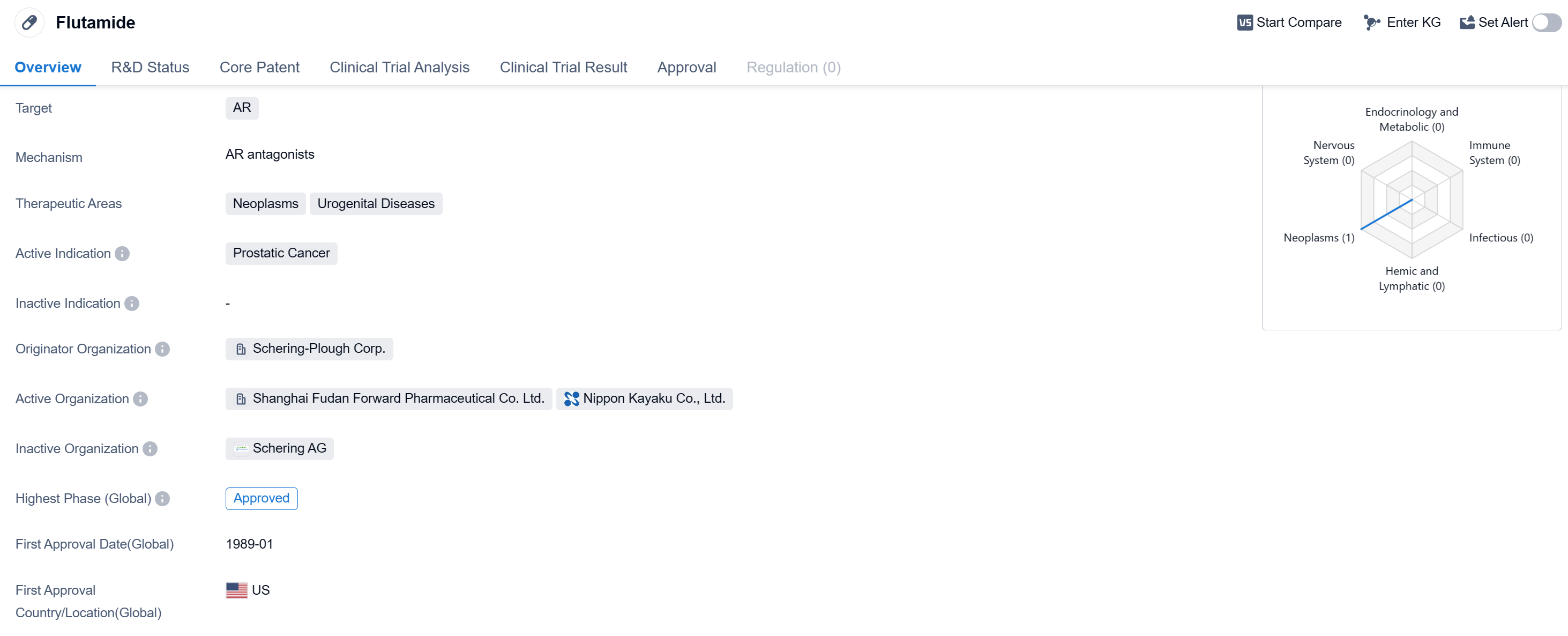An In-depth Analysis of Flutamide's R&D Progress and Mechanism of Action on Drug Target
Flutamide's R&D Progress
Flutamide is a small molecule drug that falls under the therapeutic area of neoplasms and urogenital diseases. It specifically targets the androgen receptor (AR) and is primarily used for the treatment of prostatic cancer. The drug was first approved in the United States in January 1989 and is currently approved in the global markets.
Flutamide is developed by Schering-Plough Corp., an originator organization in the pharmaceutical industry. As a small molecule drug, it is designed to interact with the androgen receptor, which plays a crucial role in the development and progression of prostatic cancer. By targeting this receptor, flutamide aims to inhibit the growth and spread of cancer cells in the prostate gland.
Flutamide has reached the highest phase of development which is approved globally.
The approval of flutamide in the United States in 1989 highlights its long-standing presence in the market and its established track record. Over the years, it has gained recognition as a reliable and effective treatment option for prostatic cancer patients.
👇Please click on the image below to directly access the latest data (R&D Status | Core Patent | Clinical Trial | Approval status in Global countries) of this drug.
Mechanism of Action for Flutamide: AR antagonists
AR antagonists are a type of medication that specifically targets and blocks the activity of the androgen receptor (AR). The androgen receptor is a protein found in cells that plays a crucial role in the development and functioning of male reproductive tissues. It is also involved in the growth and progression of certain types of cancer, such as prostate cancer.
From a biomedical perspective, AR antagonists are commonly used in the treatment of prostate cancer. By blocking the androgen receptor, these medications can inhibit the growth and spread of prostate cancer cells that rely on androgens (male hormones) for their growth. By reducing the activity of the androgen receptor, AR antagonists help to slow down the progression of the disease and alleviate symptoms associated with advanced prostate cancer.
AR antagonists can also be used in other conditions where androgen receptor activity needs to be suppressed, such as hirsutism (excessive hair growth) in women, androgenic alopecia (male pattern baldness), and certain types of hormone-dependent breast cancer.
Overall, AR antagonists are an important class of drugs that have significant clinical applications in the management of androgen-related conditions, particularly prostate cancer.
Drug Target R&D Trends for Flutamide
According to Patsnap Synapse, as of 13 Sep 2023, there are a total of 247 AR drugs worldwide, from 265 organizations, covering 173 indications, and conducting 2040 clinical trials.
The current competitive landscape for the target AR is characterized by the active involvement of several pharmaceutical companies, including Bayer AG, Pfizer Inc., Suzhou Kintor Pharmaceuticals, Inc., and Johnson & Johnson. These companies have a significant number of drugs in various stages of development, indicating their strong focus on research and development in this area. The most common indications for the target AR include Prostatic Cancer, Hypogonadism, Breast Cancer, Acne Vulgaris, Contraception, and Osteoporosis. Small molecule drugs and PROTACs are the drug types that are progressing most rapidly under the current target AR. The United States, China, and the European Union are the countries/locations that are developing fastest, with China showing significant progress in drug development for the target AR. Overall, the target AR presents a competitive landscape with multiple companies and drug types, indicating a promising future for the development of drugs in this area.
👇Please click on the picture link below for free registration or log in directly if you have a freemium account, you can browse the latest research progress on drugs, indications, organizations, clinical trials, clinical results, and drug patents related to this target
Conclusion
In summary, flutamide is a small molecule drug developed by Schering-Plough Corp. It targets the androgen receptor and is primarily used for the treatment of prostatic cancer. With approvals in the global markets, flutamide offers a valuable therapeutic option for patients diagnosed with this condition.






